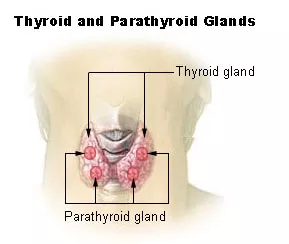Hyperparathyroidism
"As with any complex procedure, it makes sense to choose a facility and doctor that perform the operations frequently rather than rarely. When we were asking around, eight years ago, the UCSF hospital and Dr. Quan Duh came highly recommended on those grounds (and I have since heard from other patients grateful for his treatment there)."
Author James Fallows, Writing in The Atlantic.com in comments to his article, Garry Shandling and the Disease You Didn’t Know About
Primary hyperparathyroidism is a disorder of the parathyroid glands in which one or more enlarged, overactive parathyroid glands secretes too much parathyroid hormone (PTH).

The parathyroid glands are four rice-sized glands located on back of the thyroid gland in the neck. Though their names are similar, the thyroid and parathyroid glands are entirely different glands, each producing distinct hormones with specific functions.
The parathyroid glands secrete PTH, a substance that helps maintain the correct balance of calcium in the body. PTH regulates levels of calcium in the blood, release of calcium from bone, absorption of calcium in the intestine, and excretion of calcium in the urine.
What is hyperparathyroidism?
If one or more of the parathyroid glands secretes too much hormone, as happens in primary hyperparathyroidism, the balance is disrupted: blood calcium rises. This condition of excessive calcium in the blood, called hypercalcemia, is what usually signals the doctor that something may be wrong with the parathyroid glands. In 85% of people with primary hyperparathyroidism, a single benign tumor called an adenoma has formed in one of the parathyroid glands, causing it to become overactive. 99% of these adenomas are noncancerous.
This excess PTH triggers the release of too much calcium into the bloodstream. The bones may lose calcium, leading to osteoporosis. The levels of calcium may increase in the urine, causing kidney stones. Over time, untreated primary hyperparathyroidism may cause problems with the heart and blood vessels, and patients are at higher risk of dying from cardiovascular disease.

Why is calcium so important?
Calcium is essential for good health. It plays an important role in bone and tooth development and in maintaining bone strength. Calcium is also important in nerve transmission and muscle contraction.
What causes hyperparathyroidism?
In most cases doctors don't know the cause. The vast majority of cases occur in people with no family history of the disorder. Only about 5 percent of cases can be linked to an inherited problem. Familial multiple endocrine neoplasia type 1 is a rare, inherited syndrome that affects the parathyroids as well as the pancreas and the pituitary gland.
How common is hyperparathyroidism?
In the United States, about 100,000 people develop the disorder each year. Women outnumber men two to one, and risk increases with age. In women 60 years and older, 1/500 will develop hyperparathyroidism each year.
What are the symptoms of hyperparathyroidism?
A person with hyperparathyroidism may have severe symptoms, subtle ones, or none at all. Increasingly, routine blood tests that screen for a wide range of conditions, including high calcium levels, are alerting doctors to people who have mild forms of the disorder even though they are symptom-free.
When symptoms do appear, they are often mild and nonspecific, such as a feeling of weakness and fatigue, depression, or aches and pains. With more severe disease, a person may have a loss of appetite, nausea, vomiting, constipation, confusion or impaired thinking and memory, and increased thirst and urination. Patients may have thinning of the bones without symptoms, but with risk of fractures. Increased calcium and phosphorus excretion in the urine may cause kidney stones.
Diagnosis and Treatment
Hyperparathyroidism is diagnosed when tests show that blood levels of calcium and parathyroid hormone are too high. Other diseases can cause high blood calcium levels, but only in hyperparathyroidism is the elevated calcium the result of too much parathyroid hormone. A blood test that accurately measures the amount of parathyroid hormone has simplified the diagnosis of hyperparathyroidism.
Surgery to remove the enlarged gland (or glands) is the only definitive treatment for the disorder and cures it in 95 percent of operations. With the use of accurate preoperative imaging studies and intraoperative parathyroid hormone measurement, minimally invasive parathyroidectomy via a 2-3 centimeter incision is possible in the majority of cases.
Are there any complications associated with parathyroid surgery?
Surgery for hyperparathyroidism is highly successful with a low complication rate when performed by surgeons experienced with this condition. Less than 1 percent of patients will have postoperative bleeding requiring repeat operation. Less than 1 percent of patients may experience damage to the nerves controlling the vocal cords, which can affect speech. Less than 1% of patients may develop low calcium following operation which requires treatment with calcium or vitamin D.
Are parathyroid imaging tests needed before surgery?
Minimally invasive parathyroidectomy requires accurate preoperative imaging with ultrasound and sestamibi scan. If preoperative imaging does not demonstrate a single enlarged gland, then bilateral neck exploration is required.

|
Diagram showing structures in the human neck. The four green shaded areas represent the most common position of the parathyroid glands, which are generally four in number and situated behind the lateral lobes of the thyroid gland (shaded orange). By Busca tu equilibrio... (Namaste) 20:53, 18 December 2011 (UTC) (Own work) [GFDL (http://www.gnu.org/copyleft/fdl.html) or CC BY-SA 3.0 (http://creativecommons.org/licenses/by-sa/3.0)], via Wikimedia Commons |
For More Information about Parathyroid Surgery
Visit the AAES Patient Education Site
